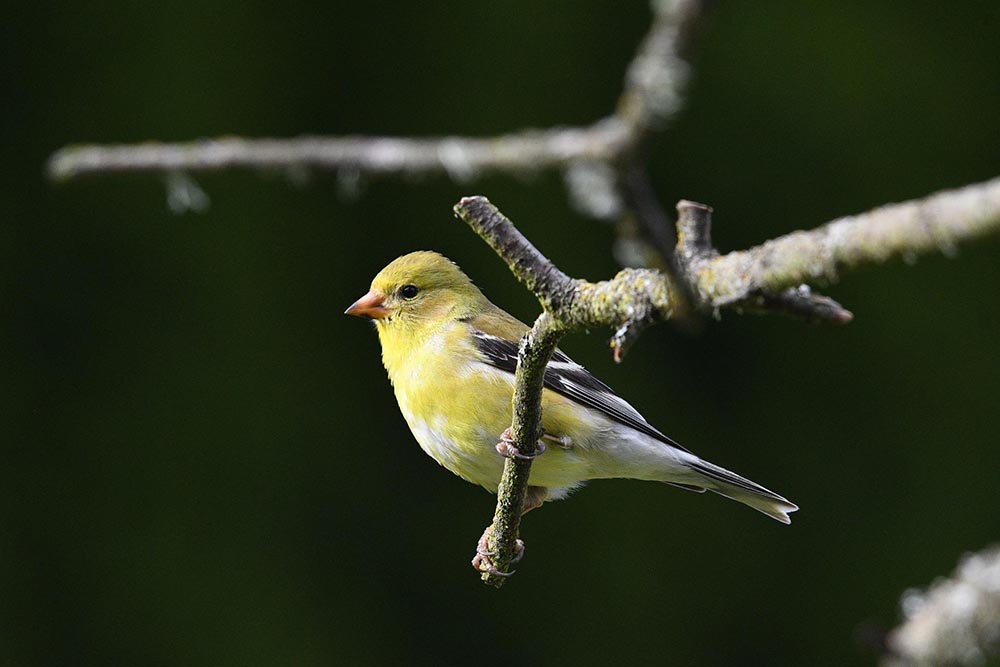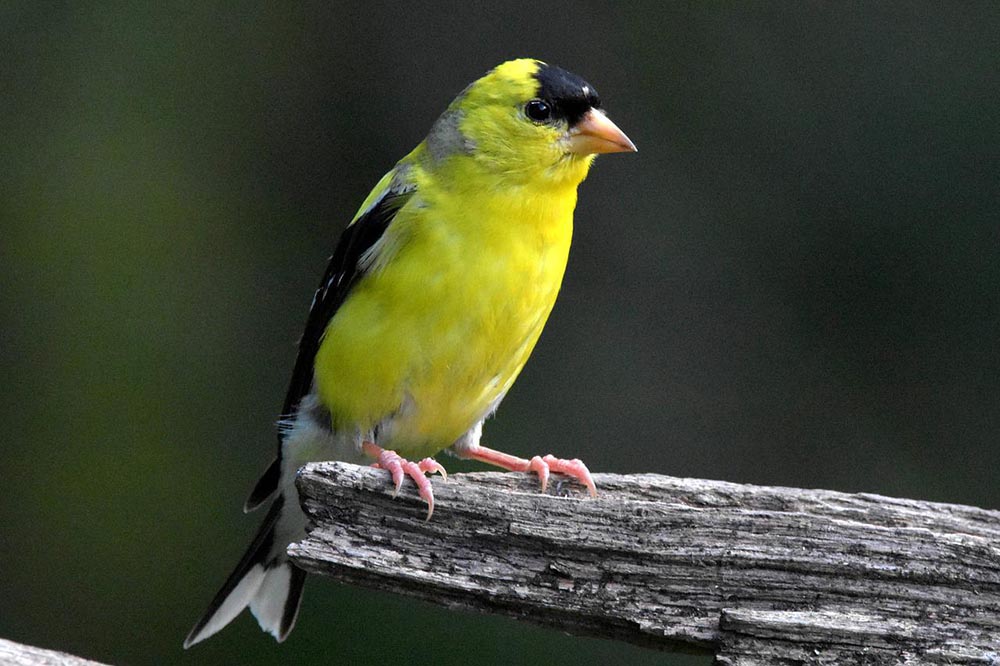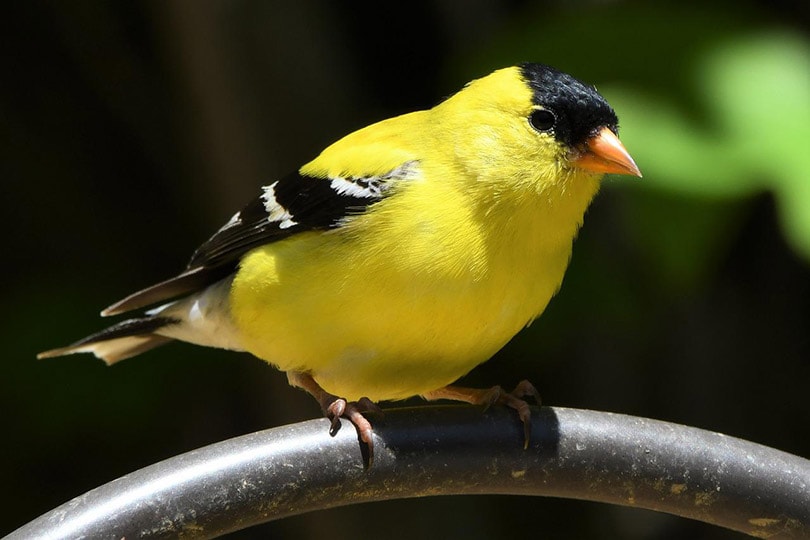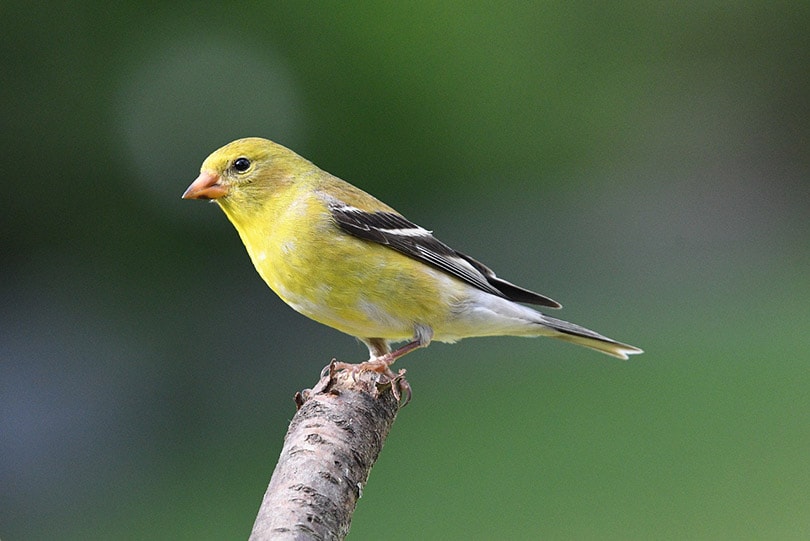20 Interesting & Fun American Goldfinch Facts You Never Knew
Last Updated on

The first time you see an American Goldfinch, you might think someone’s canary got loose. This bird is so brightly colored that it’s hard not to notice it. The contrast with its black wings makes the yellow hues pop. It is a species that demands your attention. It’s a fitting member of the avian community during the spring to fall months.
The American Goldfinch is part of the Passeriformes order, also known as perching birds. Finches are a widespread group of birds. They prefer wintering grounds that don’t get too cold because of their preferred food source.

The 20 Interesting and Fun American Goldfinch Facts
1. The American Goldfinch Is an Avian-Friendly Bird
Not all birds are willing to share their digs with others of their kind. The American Finch gets along with its bird buddies. They will feed on the same stomping grounds and protect each other from predators with their alarm calls. Of course, breeding season is another story with displays and threats that show who rules the roost.

2. Federal Law Protects the American Goldfinch
The Migratory Bird Treaty Act of 1918 protects all migrating birds to protect the populations of our avian friends on a global scale. It prohibits capturing, killing, selling, and possessing bird body parts, including feathers. A word to the wise: the fines are hefty with possible jail time.
3. The American Goldfinch Takes Its Time to Nest
Most birds have fledglings before the American Goldfinch gets around to nesting. It doesn’t start the breeding season until late June. It can have up to two broods if the conditions are suitable. Each clutch includes two to seven eggs. Depending on the location and environmental conditions, they may have more than one clutch of eggs.
4. The American Goldfinch Has a Curious Scientific Name
The genus name for this finch is spinus, which denotes a seed-eating bird. This one fits the bill. The odd part is its species name. Tristis comes from the French word for sorrowful or sad. That hardly seems suitable because of its cheery, yellow color and melodious song. We can only surmise that other reasons influenced this choice, such as its sometimes plaintive calls.

5. American Goldfinches Are Surprising Long-Lived
Based on banding data from the US Geological Survey, the oldest bird on record was 10 years and 9 months. The male finch was captured and released on May 12, 2013. It had been originally banded as a two-year-old on February 19, 2004. This species typically lives at least 3 years, with many surpassing that figure.
6. The American Goldfinch’s Call May Make You Want a Snack
Birdwatchers often give words or syllables to describe a bird’s call. This finch has one that may make you hungry. Some say that its vocalization is saying “po-ta-to-chip!” Its song sounds canary-like, which isn’t a stretch when you consider its appearance.
7. American Goldfinches Are Excellent Parents
While they’re not monogamous, American Goldfinches are good parents. While the female incubates the eggs, the male will feed her. Both share the responsibility of taking care of the newly hatched chicks. Interestingly, the male takes over parental responsibilities as the young get closer to leaving the nest.
8. The American Goldfinch Lives in a Diverse Collection of Habitats
Its name suggests that it only lives in the United States. However, this bird flies around in Mexico, the Bahamas, and even Canada. It lives in various places, from forests to shrublands. Its ability to adapt undoubtedly accounts for its relatively large range.

9. A Group of Goldfinches Has Several Interesting Names
Most of us know that a group of crows is called a murder of crows. The American Goldfinch has its take on these group names, with several reflecting their endearing personalities. How about a treasure of finches? Or can we call them a charm of finches? Either way, they have interesting names.
10. The Main Environmental Role of the American Goldfinch Is a Seed Disperser
The American Goldfinch loves its nuts and seeds. It pays it forward by dispersing them to make sure there’s food for the next generation. While bees are the pollinators, animals like birds are the dispersers that cement their role in the food web.
11. The Relationship Between Humans and the American Goldfinch Was the Beginning of a Beautiful Friendship
The relationship between some wildlife species and humans doesn’t always hit a high note. Sometimes, it’s costly. Think of deer and vehicle collisions. It’s different with the American Goldfinch. They give us pleasure from birdwatching. They have also benefited from people feeding them. While habitat fragmentation has hurt many animals, this bird has gained more habitat.

12. The American Goldfinch Has Four Subspecies
The usual evolutionary factors of geography, isolation, and adaptation have been at work with the four subspecies. They include populations in Southwestern Canada, Northwestern Mexico, Southeastern Canada, and the west-central portion of the United States.
13. The American Goldfinch Molts Twice a Year
Molting describes the process where an organism sheds some part of its body. Snakes slough off their skin. Pet owners are well-acquainted with shedding, especially if you own a Labrador Retriever. The American Finch isn’t unique because it molts and gets a new set of feathers. It stands out because it’s the only species of its kind to do it twice in the spring and fall.
14. Three States Have Named the American Goldfinch Their State Bird
Iowa, New Jersey, and Washington all have given the American Goldfinch its highest honor. However, the bird has different common names in each. They are the Eastern Goldfinch in the first two and the Willow Goldfinch in the last.
15. The American Goldfinch Has Enemies in High and Low Places
The Blue Jay, Eastern Garter Snake, and American Kestrel are among the top predators of the American Goldfinch. This bird can’t catch a break anywhere, whether it’s above them or sharing the ground with them. As if that weren’t enough, they also have to deal with Brown-Headed Cowbirds that lay their eggs in the finches’ nests to take advantage of their parental investment. Luckily, it doesn’t usually work.

16. The Flock Sizes at Bird Feeders Have Declined
Project FeederWatch has revealed some disturbing trends with the American Goldfinch. In 1989, the average flock size observed at feeders was 16.1 in the Southeast. The numbers have declined steadily, with a low of 5.7 birds in 2021. Sadly, similar trends have occurred in the other five regions.
17. The American Goldfinch’s Favorite Foods Are Nyjer and Sunflower Seeds
This bird will eat various other foods, too, including grass seeds, pine cones, grains, and the occasional insect. It’ll come to just about any type of feeder style, too. It’ll even forage on the ground if plentiful food is available. Even though they primarily eat seeds, they aren’t picky.
18. Mated Pairs Sing the Same Song
Birds often change their songs based on experience. It depends on where they live and what they’re hearing. Many have regional dialects so that you can identify the place where they live based on their vocalizations. Male and female American Goldfinches take it to the next level by replicating their songs. It probably helps with the bonding process, even if it’s just for the breeding season.
19. The American Goldfinch Is a Species of Least Concern
The numbers of this cute little bird have been stable and even increasing in some areas. Its estimated global population is a whopping 42 million individuals. Its mutually beneficial relationship with humans is undoubtedly a factor in ensuring we’ll enjoy American Goldfinches for a long time to come.

20. The American Goldfinch Is Vulnerable to Climate Change
If things stay status quo, the American Goldfinch will survive and thrive. If the global average temperature increases, the species stands to lose 34% of its summer range.

Conclusion
The American Goldfinch is an attractive bird that demands your attention. It’s a sweet creature that is friendly with others of its kind. It has adapted well to the presence of humans, which also makes this species endearing. This finch is a migrant that we look forward to seeing every spring. Its delightful song makes it even more special.
Featured Image Credit: Veronika_Andrews, Pixabay
Table of Contents
- The 20 Interesting and Fun American Goldfinch Facts
- 1. The American Goldfinch Is an Avian-Friendly Bird
- 2. Federal Law Protects the American Goldfinch
- 3. The American Goldfinch Takes Its Time to Nest
- 4. The American Goldfinch Has a Curious Scientific Name
- 5. American Goldfinches Are Surprising Long-Lived
- 6. The American Goldfinch’s Call May Make You Want a Snack
- 7. American Goldfinches Are Excellent Parents
- 8. The American Goldfinch Lives in a Diverse Collection of Habitats
- 9. A Group of Goldfinches Has Several Interesting Names
- 10. The Main Environmental Role of the American Goldfinch Is a Seed Disperser
- 11. The Relationship Between Humans and the American Goldfinch Was the Beginning of a Beautiful Friendship
- 12. The American Goldfinch Has Four Subspecies
- 13. The American Goldfinch Molts Twice a Year
- 14. Three States Have Named the American Goldfinch Their State Bird
- 15. The American Goldfinch Has Enemies in High and Low Places
- 16. The Flock Sizes at Bird Feeders Have Declined
- 17. The American Goldfinch’s Favorite Foods Are Nyjer and Sunflower Seeds
- 18. Mated Pairs Sing the Same Song
- 19. The American Goldfinch Is a Species of Least Concern
- 20. The American Goldfinch Is Vulnerable to Climate Change
- Conclusion
About the Author Chris Dinesen Rogers
Chris has been writing since 2009 on a variety of topics. Her motto with all of her writing is “science-based writing nurtured by education and critical thinking.” Chris specializes in science topics and has a special love for health and environmental topics, and animals of all shapes and sizes.
Related Articles:
10 Types of Hummingbirds in Arkansas (With Pictures)
8 Types of Hummingbirds in Nebraska (With Pictures)
5 Types of Hummingbirds in Idaho (With Pictures)
3 Types of Hummingbirds in Mississippi (With Pictures)
8 Types of Hummingbirds in Kansas (With Pictures)
5 Types of Hummingbirds in West Virginia (With Pictures)
5 Types of Hummingbirds in Ohio (With Pictures)
Where Do Nuthatches Nest? Nuthatch Nesting Habits Explained
